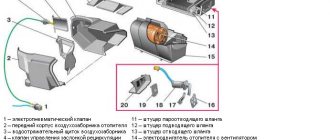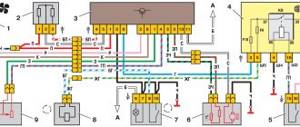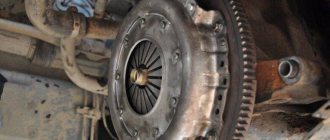But in technical terms, this system is quite complex; it is based on a large number of sensors, control units and automation. Using temperature sensors and other important components, the automation controls the entire microclimate in the car’s interior and allows you to create the necessary conditions for the trip without any problems. Today, the miracle of technology is capable of creating as many as four zones with separate climates, but this will be discussed further in the publication. We will talk about the climate control device, we will try to explain the principle of operation of all mechanisms in simple language.
It is difficult to imagine a modern car in the middle or upper price class without such an important parameter as climate control. This is one of the most popular components, which almost all buyers of new cars prefer to install on their car. Even in budget cars, manufacturers have begun to offer high-quality automatic climate control systems as optional equipment. That is, for extra money you can install climate control even on a car with a modest price tag and lack of incredibly rich equipment.
What is climate control?
The task of a car air conditioner is to supply the required amount of air, cooled to a set temperature, into the car interior. The collection is carried out from the street, from inside the car, or in mixed mode (full or partial recirculation) at the driver’s choice. The cabin heater works in a similar way, driving air flow through a radiator heated by the engine.
Important point! The heating and cooling units operate separately, independently of each other. This creates inconvenience for passengers - at times the car interior becomes too stuffy or cool, and the driver has to adjust the air temperature manually.
The difference between an air conditioner and climate control is as follows: the first is a separate unit that performs two functions - cooling and dehumidifying the air. Climate control is a system that combines several settings and is designed to automatically maintain a comfortable temperature inside the car. The system includes the following elements:
- all air conditioning units - compressor, evaporator and condenser heat exchangers, control board;
- a car heater radiator filled with hot antifreeze from the engine;
- fan - blower;
- a network of air ducts located under the front panel and diverging throughout the cabin;
- air flow distribution dampers equipped with servo drives;
- deflectors, knobs and temperature adjustment buttons;
- own electronic control unit (controller);
- air temperature sensors.
What is climate control?
Automotive climate control is an engineering solution aimed at maintaining a comfortable microclimate inside the car, regardless of environmental parameters. The standard system consists of the following elements:
- air conditioner for air cooling;
- radiator (stove) for heating;
- HVAC module;
- ventilation ducts;
- electronic control unit;
- various types of sensors.
Electronic climate control unit
The driver just needs to configure the operating parameters of the device using the electronic control unit. Having fixed a stationary temperature in various parts of the cabin, the climate control will begin to operate until the desired parameters are achieved. The system will then turn on periodically to maintain the set temperature.
Main differences
Different cars have completely different cooling and heating systems. What are the differences between air conditioning and climate control?
Air conditioning is a manual control of the temperature of the air pumped into the cabin, as well as the fan speed. This is what most cars have. You manually turn on the air conditioner, select the desired temperature and adjust the fan speed. Depending on the make and model of your vehicle, passengers may have their own controls to achieve this (two-zone operation).
Climate control is a modern, technologically advanced computerized mechanism that independently automates all processes in the car. You can change automatic settings through the on-board computer. Previously, such equipment was found only on expensive cars, but recently middle-class cars have begun to support this function.
Basically, all you have to do is enter the required temperature. The system will then use a series of internal and external sensors to adjust the air supplied to the cabin and the fan speed. There are many such systems on the market, and they all work differently depending on the automaker in question, as well as the make and model.
The main difference between air conditioning and climate control is that the latter allows passengers to set the desired temperature, and the system will automatically maintain it as conditions outside the vehicle change.
Instead of just one setting, the climate control system will allow you to set a specific temperature. Sometimes they will be in half-degree increments, ranging from about 16 to 30 degrees Celsius. Most cars also have a Max setting, which will automatically turn the heater on at full power. This is usually necessary in order to clean the windshield and car windows as quickly as possible with warm air.
Another key difference between air conditioning and climate control is that the latter will most likely have an automatic setting. In addition to the usual controls that direct air to your feet, body or head, and a button that lets you choose between fresh or recirculated cabin air, there's an Auto button that automatically adjusts airflow to maintain the desired temperature difference.
What is better – climate control or air conditioning?
Most new car owners often do not distinguish between the control device of a conventional air conditioner and the climate control system. Thus, these concepts, which have fundamental differences, are confused. By studying the operation of climate control or air conditioning, you can be convinced that an advanced intelligent climate system has a number of advantages over a conventional air conditioner:
- automatically regulates and maintains the temperature in the cabin set by the driver;
- safety for the health of passengers is ensured by the selective direction of the air flow;
- regulates not only temperature, but also humidity, preventing glass from fogging and eliminating stuffiness in the cabin;
- the ability to enable additional functions, for example, turning on air recirculation without taking in the air from outside when it is smoky, or turning on a freshener that scents the air.
When choosing climate control or air conditioning, you should take into account that the climate system is an expensive and complex system that provides greater comfort inside the car and is used almost regardless of the season. An air conditioner is cheaper, simpler to design and operate, cools the interior faster, but is used mainly only in the summer. Long-term use can lead to colds.
Video: Kia Sportage 3 Self-diagnosis and climate control adjustment
Device
It’s not difficult to figure out how to use climate control and turn on its different operating modes. But the car owner is recommended to first become familiar with the structure of this system.
It includes a large number of elements, but the main ones are 3:
- ECU. The control unit is considered the main component of climate control, since it is responsible for operating processes. Consists of a controller, software control and data input system. Electronic and mechanical regulators are used, depending on the model. Modern ECUs allow control using digital data and a remote control.
- Sensors They are installed inside and outside the vehicle. On multi-zone systems, machines use a larger number of reading devices that transmit the received information to the ECU.
- Executive devices. This is a heating system, cooling equipment, dampers, electric motor drives, fans, deflectors, various filters and other components.
We recommend: What should be the tire pressure of a car?
It is not necessary to know every element that is part of the climate control equipment. It is important for the driver to be able to competently manage the system and carry out periodic preventive measures. This will avoid serious damage and costly repairs.
Evgeny161 › Blog › Installing an air conditioner in a grant
Have a good day everyone!
I would like to share with you a post about installing the original Halla-visteon factory air conditioner (NOT AUGUST OR FROST) in GRANTA.
As it usually happens, either here on the drive, or on VKontakte in my group avtoklimat161, or in the advertisements on Avito, the owner of this grant found me...
The car is like a car and there is no air conditioner... Having told the owner about the options for installing new or used equipment, about the cost (new turnkey 50, used - 35), we agreed that we will install used equipment, especially since this year I have thoroughly stocked up on such equipment, because I think that new ones are sooooo expensive, but used ones, during pre-sale preparation, are no different in either quality or operational efficiency!
In my opinion, the Granta is best suited to be equipped with air conditioning. The installation process is not particularly complicated, a standard “locksmith” - unscrewed - removed - took another - installed - screwed.
But there are things with which there are problems with grants!
1. On cars without air conditioner there is NO belt tensioner mechanism! That is, you need to buy a Kalinovsky generator bracket with an adjusting screw and a roller.
2. The most important thing is that on grants, depending on the ECU model and firmware, you must use either a THREE-CONTACT coolant pressure sensor or a FOUR-PIN! And they are not interchangeable! Apparently, this is why FROST kits do not have a connection to the computer, so as not to worry about what firmware is there and what unit is there. And this is categorically NOT CORRECT! ! THE ECU SHOULD KNOW THAT THE AIR CONDITIONING IS ON. MOREover, IT IS THE ECU THAT TURNES ON THE MAIN FAN AND COMPRESSOR AND CORRECTS THE IDLE SPEED, AND ALSO TURN OFF THE COMPRESSOR WHEN SHARPLY PRESSING THE GAS PEDAL, THUS MAKING IT EASIER FOR THE ENGINE TO GET RPM SHARPLY - IT HELPS VERY WHEN OVERTAKING ESPECIALLY ON TRAIN.
What is climate control in a car?
Climate control in a car is a system that automatically maintains a set temperature in the cabin. The installation combines heater units, as well as an air conditioner and a heated or cooled air supply system into a single whole. The operation of the complex is ensured by various sensors installed in the cabin and on the system elements. This is the main difference between the climate and a conventional air conditioner, which must be adjusted manually.
Some cars use air conditioners with an additional automatic mode. This scheme is not full-fledged climate control, although it ensures the maintenance of air temperature.
Climate control system design
The microclimate installation for a car includes the following components:
- 1 — operating mode switch;
- 2 - valve on the compressor, protecting the system from high pressure;
- 3 — fan impeller installed on the radiator;
- 4 - air conditioner switch, operating from pressure in the line;
- 5 — coolant temperature sensor in the engine jacket;
- 6 — thermal switch for fan operating modes on the radiator;
- 7 - evaporator with a temperature sensor installed inside;
- 8 — impeller for supplying air to the climate control system;
- 9 — control unit for the fuel injection system;
- 10 - electromagnetic clutch used to drive the compressor;
- 11 - electronic climate control unit.
Air conditioning units
The device of the air conditioning unit itself:
- 1 — engine with a damper in the air duct;
- 2 — heater radiator;
- 3 - drive of the damper for removing part of the air into the heater;
- 4 — regulator of the intensity of air intake from outside;
- 5 — recirculation valve flap;
- 6 — flow of incoming air;
- 7 — motor for air flow and recirculation dampers;
- 8 — fan impeller;
- 9 — evaporator block;
- 10 - distribution valve;
- 11 — supply of air flow to the cabin.
Climate system units
On a number of cars, the air conditioning system includes an electric heater, which provides warm air immediately after starting the engine.
The simplest climate control system includes sensors:
- outdoor air temperature sensor, located in the front bumper area;
- temperature meter in the foot area;
- temperature sensor on the instrument panel;
- a photo sensor that measures solar radiation activity;
- temperature meter for air taken from the street.
Location of sensors in the car
Data from the sensors enters the climate control unit. If any device fails, the control unit uses a fixed temperature value stored in the program to operate.
Basic functions of climate control components
The components included provide:
- The radiator and fan are used to cool the refrigerant. You can use your own fan or a shared impeller with the cooling system.
- Built-in protective sensors ensure correct operation of the microclimate, turning off the cooling system in the event of a malfunction or refrigerant leak.
- The unit's compressor compresses the refrigerant, which, when expanded, cools the evaporator. The refrigerant enters the evaporator radiator in liquid form, evaporation occurs only in the radiator. In this way, the greatest efficiency of the system is achieved.
- The electromagnetic clutch turns the compressor on and off as needed. On vehicles equipped with an automatic transmission, the clutch disengages the compressor in kickdown mode. This ensures the most intense acceleration possible.
- The climate control unit is a separate device equipped with a display, rotary controls and buttons. The module receives information from various system sensors and processes the data in accordance with the established algorithm. Then the formation of command signals occurs, which are supplied to the actuators. The units can be equipped with a memory module that stores error codes. Based on the codes, you can understand which element of the air conditioning system is faulty or is experiencing periodic malfunctions.
- The temperature sensor is located in the control unit or instrument panel. The device is placed in the air flow to ensure maximum measurement accuracy. The air supply is carried out by a separate small-sized fan.
Additional climate control modes
Depending on the design, the climate control system may have additional capabilities:
- supply of warm or cold air in three directions (glass, footwell, head area);
- manual operating mode;
- synchronous mode (for multi-zone systems);
- air recirculation in the cabin;
- forced system shutdown;
- displaying additional information on the control unit screen (available on some vehicles).
Types of climate control systems and their features
The concept of type of climate control mainly refers to the number of zones into which air of different temperatures is supplied. Installations may also differ in additional functions, for example, the presence of an air ionizer.
In cars there are options:
- Single-zone installation is a simple climate control option. The air supplied to the driver and front passenger seats has the same temperature. The same flow is supplied to the rear row of seats through ducts located under the front seats or inside the center console.
- Dual-zone type that separates air flow between the driver and front passenger. The back row receives air of different temperatures.
- Three-zone system that allows you to set an individual temperature value for passengers in the rear row of seats. To operate a three-zone climate, a separate installation located in the console can be used. But as a rule, one device is used, which leads to an error between the set and actual air temperature.
- Four-zone climate control, allowing you to set your own air temperature for each passenger. The most complex and advanced type of installation used on premium cars.
We recommend: How to determine what engine oil consumption is considered normal?
The basic version of the climate control system distributes flows in the following directions:
- foot niches;
- upper part of the cabin at head level;
- combined mode of air supply to the legs and head area;
- windshield and footwell;
- maximum flow onto the windshield used for defrosting and removing condensation.
Multi-zone climate control options have additional operating modes and combinations of air supply directions.
Lada Kalina Cross Mr. Carrot › Logbook › Climate control or installation?
- So what do we have? - Not us, but you. - No, this time it’s us!
And we have climate control. Which at the plant, according to Russian tradition, was renamed into a “climate control unit”. Yes, the climate control is single-zone. Yes, it looks like a simple three ventilation control knobs. Yes, turning on auto mode is, in my opinion, stupid. But this is full-fledged climate control and even more complete than on the Primera. And this inclusion of auto mode was probably done for the sake of design. So as not to make a separate button.
In auto mode, the climate itself distributes the flow, turns the air conditioning on and off, controls the stove and, of course, controls the blowing speed. All this depends on the position of the temperature knob. In general, ordinary climate control, only without a display.
My brother had climate control on the Primera. And with a display. There was actually a huge display in the center to control anything and everything. The temperature was set in degrees Celsius. But the Primierovsky Climate air conditioner could not turn on or off on its own. Only by hand. You get into the Premiere, start it, and the climate in the cabin becomes a hurricane. You look, and the air conditioner is turned off. And the climate regularly tries to use 30-degree outside air to cool the interior to the set 24 degrees. You turn on the air conditioner, the temperature drops and the fan immediately calms down.
And the fact that I don’t know what temperature is set on Kalina doesn’t bother me at all. If I'm cold, I turn the temperature knob to the right. If it's hot, go left. And that’s all business.
Moreover, in auto and manual mode, the temperature knob sets different temperatures. If you turn off auto mode (for example, set the fan to first speed), then when the air conditioner is on, the air temperature from the ventilation will be lower than in auto mode. And when turned off, it is correspondingly higher than in the car.
Moreover, if in auto mode you turn the temperature knob to the right all the way, the air conditioner will turn off in any case. If it’s hot outside, the climate will let in outside air without heating.
Basic principles of operation of a modern climate control system
In the context of talking about automatic climate control in a car, it is worth highlighting cheap and expensive climate control options. The cheap design consists of a single sensor, which is usually located on the roof. This is not the most efficient way to measure the temperature in the cabin, and comparing the internal and external temperatures will be useful. While the temperature in the upper part of the cabin reaches the set value, the passengers' feet will be very cold (or hot, if we are talking about winter). Such systems are not very effective; they are most often used in Chinese cars. An expensive climate control system uses a whole group of sensors:
- the temperature in the cabin is measured at two levels - below and above, sensors on the door cards are also possible;
- a comparison with the external temperature is required, which allows optimizing the operation of the system;
- there is a solar heating sensor on the panel, which also optimizes the operation of the automation;
- inside the air conditioner there are freon pressure sensors that provide information about the safety of the installation;
- with aggressive temperature settings, the on-board computer can independently optimize the operation of the installation;
- Some cars also have air humidity sensors, and this parameter can be configured;
- Air recovery is switched on automatically in many modern cars when foreign impurities appear.
This means that the driver only needs to indicate the desired temperature, and the air conditioner or heater will automatically switch to the desired operating mode. To do this, the automation uses the readings of all sensors, analyzes and compares the data, and issues commands to the climate modules. Such solutions make it possible to easily establish the necessary modes under operating conditions of the air conditioner and heater. Also in some cars there is automatic air ventilation and humidification if necessary. However, humidifiers turn on depending on the set temperature.
Operational features of the climate control system
The convenience of operating the climate-forming system lies in its complete automation. The driver just needs to indicate the desired temperature readings on the display, after which the program itself will establish the procedure for achieving the specified result.
The most optimal operation of the climate-forming system is considered to be when the internal circulation of the car ventilation system is in the “ON” mode. In this case, the climate-forming system is always in standby mode, ready to promptly “adjust” the temperature conditions in the car interior. However, it is recommended that the driver perform the operations of blocking the deflectors and selecting the required direction of air flow independently.
Air recirculation should be taken as seriously as possible. The consequence of the cooling being in the “OFF” mode can be the formation of condensation on the evaporator, fogging of the windows and the formation of an unpleasant odor in the car interior.
During the hot season, the climate control system should operate as follows:
- The driver must open the doors and windows of the car and wait for the temperature of the interior and the environment to become equal.
- Close the doors and windows, set the recirculation mode to maximum.
- Get out of the car for a while.
When driving the vehicle with the climate control system turned on, you should avoid introducing air from outside. It can affect changes in sensor readings. In any case, regardless of the time of year, the climate-forming system helps to increase fuel consumption.
Diagnosis of climate control serviceability on video:
How does the climate control system work?
The introduction of climate control made it possible to coordinate the operation of heating and air conditioning installations and subordinate them to one control center. Plus, temperature limitation is implemented using internal and external sensors - based on their readings, the controller regulates the intensity of cooling or heating.
In winter, the climate control in the car works as follows:
- The air flow entering through the inlet enters the air duct and heat exchanger - the air conditioner evaporator. Upon contact with the cold fins of the radiator, condensation forms and the air is dried.
- Next, a system of dampers equipped with electric drives directs part of the flow to the heater radiator for heating.
- At the outlet of the heat exchanger, hot air is mixed with cold air to achieve the set temperature. The proportions are regulated by a controller that receives a signal from the corresponding sensor.
- The mixed flow moves through the air ducts into the cabin, exiting through the front panel deflectors or at the feet of the passengers.
Note. During the automatic control process, the electronic control unit also relies on the readings of an external temperature sensor. If it’s frosty outside, the controller will direct air to the heater; during hot weather, it will only pass through the cooler.
In summer, the processing of the air mass by the climate control system is simplified - the flow does not need to be heated in a heater and mixed. The control unit only deals with air conditioning - after cooling to the required temperature, it stops the compressor. The unit is turned on by a signal from the cabin sensor, informing that the air is heated by 3–5 °C.
In winter, budget versions of systems can direct a barely warm flow directly to passengers when the car engine has not yet warmed up. Therefore, at this stage the driver has to intervene in the climate control and adjust the heating manually. The difference between cheaper and more expensive installations is as follows: the latter do not blow air into the face or feet of passengers until it warms up. In the first minutes of engine operation, the flaps direct air flows to the windows.
If the driver sets the desired temperature (the range of 22–24 °C is considered comfortable) and activates the “Auto” mode, the controller itself decides on the intensity of heating (or cooling), direction and power of flows. In most cars, the temperature is regulated between 14–28 °C.
How climate control systems work
The climate-forming system is equipment consisting of the climate control unit itself and a program for its control. The air conditioning system is an element of harmonious combination of the functions of ventilation, heating and air conditioning. The control system is responsible for regulating and monitoring the equipment used. It consists of a number of sensors:
- Sensor for determining the pressure of the air conditioning system;
- Sensors for determining air temperature indicators inside and outside the car;
- Sensor for determining the degree of solar radiation.
The essence of its operation is the reception of sensor signals by the control unit and their transmission to a specific actuator. Based on the data obtained, the changed indicators are regulated.
How climate control works is shown in the video:
How does an air conditioner work?
Since recently there has been a rise in fuel prices and an economic crisis, many car enthusiasts are in favor of abolishing the use of car air conditioners. There are many recommendations for overall energy savings, and the use of integrated factory cooling is one of the main factors for poor fuel economy.
Opponents of air conditioners recommend using traditional ventilation, which is air entering through the window. Of course, this version is very impractical, especially in winter, when an open window can cause flu and inflammation. However, to choose the solution that's best for you, you should first consider the most common advantages and disadvantages of using air conditioning in your car.
We recommend: What is the difference between a strut and a shock absorber?
Actively cooling the interior with air conditioning can increase overall gas consumption by 10%! Research has shown that opening windows for ventilation when driving at an average speed of 70 km/h (or lower) will provide your car with maximum efficiency in terms of fuel consumption and comfort.
In most standard situations (driving around town, going to the mall, meeting with friends or relatives), it is easiest to always ventilate the car with natural air, unless the environment and temperature will cause you discomfort or affect the proper functioning of the vehicle. This way, from spring to fall, you can keep your car windows open when the heat allows, while keeping fuel consumption as low as possible.
Let's start with the refrigerant (r134a) inside the system. This refrigerant was specifically created for the automotive industry in the late 1980s and is somewhat different from household or industrial refrigerants. Some call it "Freon".
Some of the gas is held under pressure within the system. When the system is not operating, the refrigerant remains a gas under low pressure. The optimal property of the gas is its ability to come out of a hot state when it is compressed, and when cooled in a condenser located in front of the radiator, it turns into a pressurized liquid, which is then released through an expansion valve or diaphragm (small hole). The high-pressure liquid instantly turns into low-pressure vapor, which creates cold inside the evaporator, in which case the fan motor forces air through it into the ventilation system and into the inside of the machine.
The evaporator core looks like a small radiator that is located inside the car. Once the refrigerant has used up its cold charge, it is collected in a low pressure hose and to the compressor where it is processed again. Refrigerant is transferred from one component to another using hoses or pipes. The high pressure side hose connects the compressor to the condenser, from the condenser to the expansion valve or vented tube that is located in front of the evaporator. The low side connects the evaporator to the compressor. An expansion valve or diaphragm does essentially the same job, and the system may have one or the other. The expansion valve can be of different sizes depending on the temperature, while the diaphragm has a fixed size.
Car air conditioner
When is it good to use air conditioner?
If you exceed the speed of 70-80 kilometers per hour, as is usually the case on long trips to another city, it is better to keep the windows closed and use the air conditioning system. Open windows will increase fuel consumption by as much as 20%! Strong airflow slows the car down and makes it even more unstable, not to mention clunky to handle. But driving quickly with the windows closed is uncomfortable, so when driving at higher speeds, it is recommended to use air conditioning.
In addition to air conditioning, there are other solutions that allow you to ventilate your car and maintain comfort inside it. Firstly, the main fan of the car, if it is vented into the passenger compartment, can ventilate the car quite well and reduce its temperature. It can also change the smell in the car, namely, get rid of fuel or street “aroma”. It's best to use this setting to its maximum, but you can choose less intense settings if you prefer.
Another very simple way is to park your car in a parking lot or in a cool place in the shade. On a hot day you will benefit in terms of comfort and fuel consumption will be reduced.
Prevention and proper operation
An air conditioner or heater operating as part of climate control must be maintained in optimal technical condition.
Drivers make basic mistakes when operating the system and do not really understand how climate control works in a car.
There are several recommendations that will help avoid unwanted breakdowns and costly repairs to the CC:
- check the system for leaks at least once a year, since the refrigerant used can leak through cracked pipes, loose fasteners and other damaged areas;
- monitor the coolant level and refill as it decreases (this is cheaper than completely refilling the system);
- For repairs and maintenance, contact only specialized service centers, since it is not recommended to repair such equipment yourself;
- in parallel with refueling, diagnose the operation of the electronic unit;
- It is recommended to turn on the system at least 1 minute after starting the engine and turn it off at least 1 minute before stopping the engine;
- to avoid health problems, set the temperature inside the cabin to no lower than 10 degrees compared to the outside temperature (if it is 30 degrees Celsius outside, it is recommended to turn on the air conditioning no colder than 20 degrees);
- Change the cabin filter periodically, especially if you regularly use cooling and heating;
- clean the radiator (air conditioner) to get rid of accumulated dust, turning on the blowing mode once a month for 5 - 10 minutes;
- Clean the interior ventilation using available methods to get rid of contaminants and accumulated harmful microorganisms.
Simple measures that will help extend the life of your climate control equipment. If you do not follow these recommendations, you will regularly encounter problems and costly repairs.











